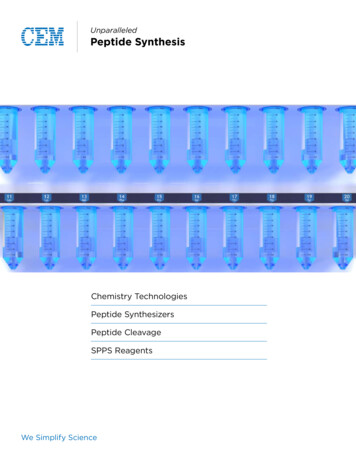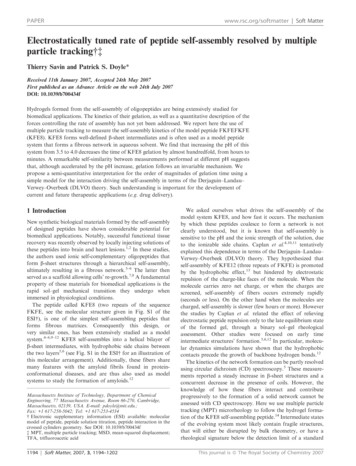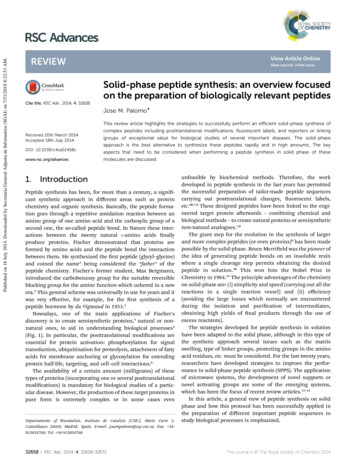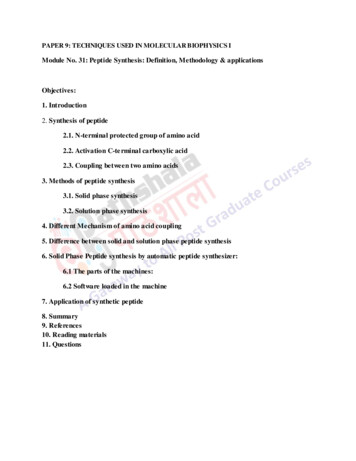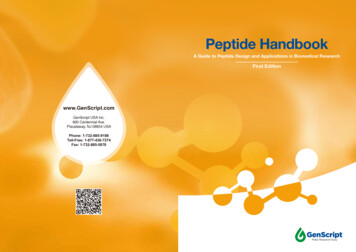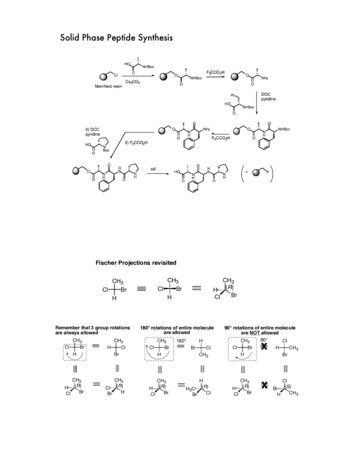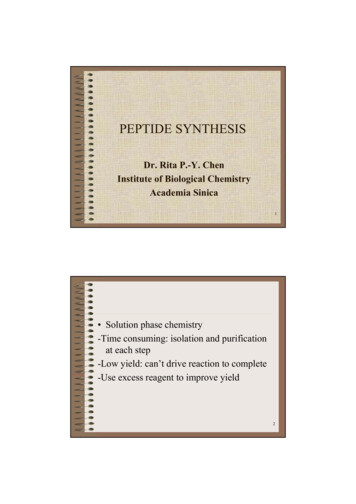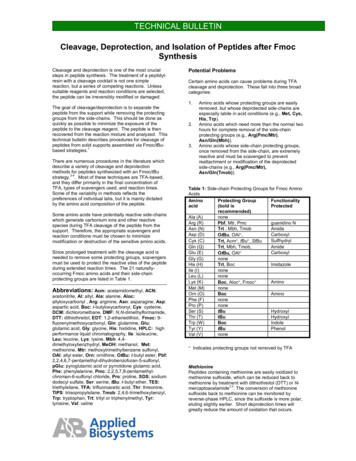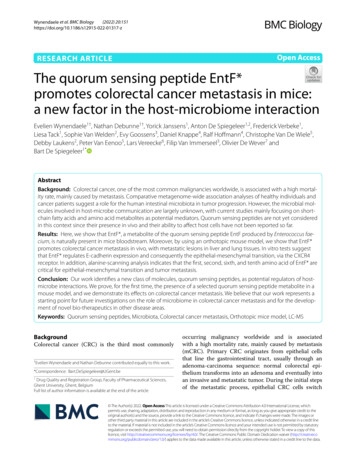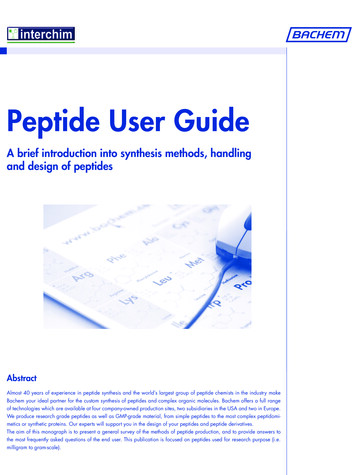
Transcription
Peptide User GuideA brief introduction into synthesis methods, handlingand design of peptidesAbstractAlmost 40 years of experience in peptide synthesis and the world’s largest group of peptide chemists in the industry makeBachem your ideal partner for the custom synthesis of peptides and complex organic molecules. Bachem offers a full rangeof technologies which are available at four company-owned production sites, two subsidiaries in the USA and two in Europe.We produce research grade peptides as well as GMP-grade material, from simple peptides to the most complex peptidomimetics or synthetic proteins. Our experts will support you in the design of your peptides and peptide derivatives.The aim of this monograph is to present a general survey of the methods of peptide production, and to provide answers tothe most frequently asked questions of the end user. This publication is focused on peptides used for research purpose (i.e.milligram to gram-scale).
Copyright by Bachem AG, 4416 Bubendorf - Switzerland. Reproduction forbidden without permission.
Table of ContentsPeptide Synthesis2The Principle of Solid-Phase Peptide Synthesis (SPPS)Solid SupportProtecting GroupsFmoc/tBu or Boc/Bzl StrategyLong Peptides22223Peptide Purification3Quality Control of Peptides4Definition of PurityDefinition of Net Peptide ContentImpuritiesBatch-to-batch Variability of PeptidesRecommended Purity Grades for VaryingApplicationsPeptide AnalysisHow to Design Your Custom PeptideLength of PeptidePolarityAmino Acids Prone to Undergo Side Reactionsb-Sheet FormationPeptide ModificationsCare and Handling of PeptidesHandling of Lyophilized PeptidesSolubilization of PeptidesStorage of Peptides in Solution44555577788913131314Delivery Time14Most Frequently Asked othe Calculation of PricesQuotation Inquiries and Ordersthe SynthesisPurity and Analytical MethodsHandling and e User Guide 1
Peptide SynthesisPeptides can be obtained chemically by “classical” solution synthesis, by solid-phase peptide synthesis (SPPS),or by a combination of both methods, which can involve native chemical ligation. Normally, at Bachem,the synthesis of peptides is carried out on solid phase,whereas the classical approach is chosen for synthesizing di- and tripeptides, and, occasionally, C-terminally modified peptides such as enzyme substrates.In the following paragraphs we will discuss the solidphase approach in more detail, as this methodologyis of utmost importance for the synthesis of peptides.The Principle of Solid-Phase Peptide SynthesisDuring solid-phase peptide synthesis, a peptide whichis anchored by its C-terminus to an insoluble polymer,is assembled by the successive addition of protectedamino acids constituting its primary structure. Hence,the peptide is elongated in the C to N direction.Peptides are synthesized from the C-terminus to theN-terminus of the sequence.A synthetic cycle consists of: Cleavage of the a-amino protecting group Washing steps to remove the cleavage reagent Coupling of the protected amino acid Washing steps to remove excessive materialAs the growing chain is linked to an insoluble support excesses of reagents and by-products can be removed by repetitive washings with appropriate solvents.Only solvents which swell the peptide resin properlycan be used for deprotection and coupling, whereasthe washing protocol may include shrinking steps.After completion of the synthesis, the desired peptide is cleaved from the resin. Usually, this cleavagestep is performed with acids of varying strength.the amino acids. The latter groups have to withstand theconditions of the repetitive cleavages of the temporaryprotecting group; usually, they are removed only duringthe cleavage from the carrier resin. Untimely removal ofprotecting groups is a common cause for the formation ofby-products. The best strategy to avoid this risk consists ofintroducing temporary and permanent protecting groups,which can be removed by differing chemical mechanisms, i.e. orthogonal protection. Truly orthogonal protecting groups may be split off with absolute selectivityand in any order. The “classical” Boc/Bzl-strategy doesnot fulfill this requirement, as both groups are cleavedwith acid. However, their acid lability differs sufficiently to afford selective removal of the a-amino protection.The combination Boc/Bzl may be called quasi-orthogonal. The pairing Fmoc/tBu, on the other hand, is trulyorthogonal. The temporary a-amino group is deblockedwith base (piperidine). Thus, TFA-labile and simultaneously base-stable groups as tBu and Boc (in combinationwith a TFA-labile anchor) are the perfect choice for sidechain protection. Orthogonal protection schemes permitmilder overall reaction conditions as well as the synthesis of partly protected or side-chain modified peptides.Fmoc/tBu or Boc/Bzl StrategyThe Boc/Bzl-strategy can be traced back to the beginnings of SPPS, Merrifield’s pioneering work. This methodology requires anchoring groups, which tolerate repetitive TFA treatment.HXFmocPlinkercoupling ofFmoc-AA1(PG1)-OHPG1vAA1linkerPpiperidineThe Solid SupportProtecting GroupsTwo categories of protecting groups are required forsynthesizing peptides: groups allowing temporary protection of the a-amino group and “permanent” protecting groups blocking the side-chain functionalities of2 Peptide User GuideAA1HvTFA-labileHAA4vPG3PG2PG1AA3AA2AA1further coupling anddeprotection stepsvvvAA4vAA3General Scheme of Fmoc-SPPSPlinkernot all amino acidsrequire side-chain protectionHPlinkervPolystyrene, crosslinked with 1% divinylbenzene, is stillthe most popular carrier resin in SPPS. It is chemicallyinert under the conditions of SPPS, and it is readily derivatized allowing the introduction of a large variety ofanchoring groups. The resulting resin swells sufficientlyin solvents suitable for SPPS. The choice of the anchoringmoiety is determined by the chosen synthetic strategyand by the type of C-terminus of the desired peptide.PG1AA2trifluoroaceticacid (TFA)AA1XH desiredpeptide(X O, NH; AAi Amino Acid; PGi Protecting Group)
Usually, the inorganic acid HF is employed for the final cleavage, which limits the batch size in this stepand the choice of reactor. Even though many remarkable synthetic successes employing Boc/Bzl-technology are recorded in the literature, the developmentof orthogonal protection schemes increased the flexibility of the solid-phase method. The Fmoc/tBu-strategy (see scheme) is the most popular amongst them.It can be automated far more conveniently than the Boc/Bzl-strategy and it can be scaled as needed. Additionallevels of orthogonality allow the synthesis of highly complex peptides. Nevertheless, depending on the sequence,the Boc/Bzl-strategy still can remain a viable alternative.FmocBocRoutine synthesisrequires specialequipmentAcid-sensitive peptidesand derivatives, e.g.O-glycosylated or sulfatedpeptidesBase-labile peptides„difficult sequences“(aggregation impeded byrepetitive TFA-treatment)Long Peptides (up to 100 Amino Acids)Our customers’ request for long peptides (up to 80-100amino acids) is increasing. Such large molecules couldbe successfully synthesized at Bachem by stepwise SPPSfollowing the described strategies. However, with increasing peptide length, this standard approach may fail. Tofulfill our customers’ requirements nevertheless, the NativeChemical Ligation (NCL) technology was established atBachem. NCL was developed by Kent as a viable alternative to stepwise SPPS for synthesizing very long peptides.Synthetic strategies comprising stepwise elongation of thepeptide may yield a very impure crude product, whichcannot be purified by standard chromatographic protocols. The chemoselective coupling of unprotected peptidefragments is the essential feature of NCL, thus subsequentpurification is reduced to removing unreacted fragments.The required segments are obtained by SPPS. Even thechemical synthesis of small proteins has become feasible,at least research quantities (10-20 mg) could be obtainedemploying a combination of stepwise SPPS and chemicalligation. The synthesis of proteins by this convergent approach is a viable alternative to standard recombinanttechnologies offering a plethora of additional options.However, due to the high costs of NCL, this technologywill not become a routine method for synthesizing longpeptides for research purposes.As the necessary know-how and the requiredequipment for performing Boc and Fmoc syntheses are available at Bachem, the synthetic strategy for your peptide can be optimized. Bachemhas already succeeded in the synthesis of verycomplex peptides, which could not be producedelsewhere.Peptide PurificationThe properties of an individual peptide dependon the composition and sequence of amino acids.Acidolytic cleavage following SPPS yields a crude product containing the desired peptide and impurities such asdeletion peptides, truncated peptides, incompletely deprotected peptides, modified peptides, scavengers andby-products derived from the cleaved protecting groups.All these contaminants have to be removed. Purificationof synthetic peptides is routinely carried out by reversedphase high performance liquid chromatography (RPHPLC) using C18-modified silica as the stationary phaseand UV peak detection. The target peptide and impurities are retained by the stationary phase depending ontheir hydrophobicity. Very polar contaminants will eluteat the beginning with aqueous 0.1% TFA, then the polarity of the eluent is gradually reduced by continuouslyincreasing the proportion of the less polar modifier, acetonitrile (a linear gradient is formed, the concentrationof TFA is kept constant). The elution of material is monitored at 220 nm. Fractions containing sufficiently puretarget peptide, as determined by analytical HPLC, arepooled and lyophilized. If the desired compound cannot be obtained sufficiently pure by RP-HPLC applyingthe standard TFA-system, an appropriate combination ofbuffer systems will be developed. If the C18 stationaryphase is too hydrophobic, e.g. when purifying less polarpeptides, other column packing materials are selected.Peptide User Guide 3
Quality Control of PeptidesDefinition of Peptide PurityDefinition of the Net Peptide Content (NPC)The purity of the lyophilized target peptide is determined by analytical RP-HPLC followed by UV detectionat 220 nm. It is quantified as area percentage, as it cor-If not requested otherwise, peptides are isolated andprovided as trifluoroacetates containing residual water.In accordance with the number of basic functionalitiesAbsorbanceAbsorbance210210– –220220nmnmAbsorbanceAbsorbance210210– notvisiblevisible00RetentionRetentionTimeTime5 5minminSchematic Analytical RP-HPLC Chromatogramsresponds to the area of the main peak in relation to thetotal area of all peaks, i.e. all material (including therequested peptide) which absorbs at this wavelength.Amide bonds and other chromophors absorb at 220 nm,whereas water and residual salts are not detected UVspectrophotometrically. The ability of this method to detect and quantify impurities eluting in the proximity of theproduct peak, i.e. an adequate resolution, is essential.The resolution of analytical HPLC can be improved by judicious choice of the buffer system, the stationary phase,the steepness of the gradient, the column temperature andother parameters. A small change of one of these parameters may turn a barely resolved shoulder into a closelyeluting peak which can be integrated and thus quantified. This is demonstrated by the HPLC-profiles above.For scrutinizing synthetic peptides by RP-HPLC and othermethods, the expert knowledge and the know-how of theanalyst are of utmost importance. Bachem’s analytical department profits from decades of experience in analyzingpeptides combined with cutting edge HPLC equipment.Lyophilizates of peptides contain varying amounts ofnon-covalently bound water. Normally, the peptide is delivered as the TFA salt which results from the RP-HPLC purification. The side-chain functionalities of Arg, Lys andHis and the free N-terminus will form trifluoroacetates,small amounts of TFA may adhere to the peptide. Thesecontaminants cannot be detected by analytical HPLC.Other salt forms of your peptide (e.g. acetate, hydrochloride) will be produced upon special request.Absolutequantity ofpeptide4 Peptide User Guide QuantityofxlyophilizatePurity(%) x NPC(%)10 000On request, Bachem will analyze your peptidein two or more different buffer systems, thoughadditional HPLC analyses increase the cost of acustom product. Actually, we refer to the lowestvalue of HPLC purity we obtain as the final purity, not the average.present in the peptide, they may contain a considerablenumber of counter-ions. Besides, lyophilizates of suchsalts are rather hygroscopic. Both water and counter-ionsreduce the net peptide content.The net peptide content is defined as the percentage ofpeptides relative to non-peptidic material, mostly counterions and moisture.At Bachem, peptides used for quantitativestudies are always provided with theirNet Peptide Content.Net peptide content and purity are not equivalent, as theNPC includes peptidic contaminants. A low NPC has tobe expected for peptides containing a large proportionof basic amino acids, even if they are extremely pure.Hydrophilic peptides can absorb considerable amountsof moisture.The NPC can vary from batch to batch, depending on theconditions of final purification and lyophilization.The NPC is determined by amino acid analysis and, asthe non-peptidic contaminants do not contain nitrogen, it
can be determined by elemental analysis. Net peptidecontent and purity have to be taken into considerationwhen preparing solutions of biologically active peptidesfor assays.ImpuritiesAfter isolation and purification impurities may still contaminate the peptide, amongst them deletion sequences(peptides lacking at least one of the required aminoacids), incompletely deprotected sequences, truncatedpeptides, by-products formed during peptide synthesis orunder the conditions of cleavage.Except for TFA, all potentially cytotoxic reagents used inthe course of the synthesis should have been removed bythe washings preceding the final cleavage or during thepurification process. Traces of residual solvents can bedetermined by gas chromatography (GC) if required.Recommended Peptide Purity for Varying ApplicationsFour standard product grades are offered by Bachembut intermediate purity ranges can be provided on demand. The lower the level of purity, the lower the pricewill be. The correlation between purity and price is notlinear, efforts and costs for obtaining very pure peptides(97-99%) may increase exponentially.Purity 97% NMR studies Crystallography studies Peptides used as reference in finalquantitative studies: Enzyme-substrate studies Receptor-ligand interaction studies Blocking and competition assays 95% Production of monoclonal antibodies Enzyme-substrate studies (quantitative) Receptor-ligand interaction studies(quantitative) Blocking and competition assays(quantitative) ELISA and RIA (quantitative) In vivo/in vitro studies 80% Western blotting studies (non-quantitative) Enzyme-substrate studies (non-quantitative) Phosphorylation studiesBatch-to-batch Variability of PeptidesThe purity of a peptide, i.e. the proportion of desiredproduct, can vary from batch to batch. When a peptideis ordered at 80% purity, the quality of the product canrange between 80% and 100%. The lower the requestedpurity, the broader the observed variability between twolots. Hence, results obtained from quantitative assayscould vary unpredictably depending on the quality of theparticular batch. Batches of low purity contain a considerable number of peptidic by-products. Proportion andstructure of these contaminants will vary from batch tobatch. Peptidic impurities may show biological activity aswell, but not necessarily the activity of the target peptide.In the worst case they may interfere with the assay.The NPC can vary as well. It is influenced by the polarityof the peptide, the conditions of lyophilization, the conditions and duration of storage, contact with humidity andmany other parameters.Crude peptides should not be used in biological assays,even if the assay could be conducted employing a lowpurity product. The material obtained after cleavage fromthe resin and precipitation still may contain a range ofharmful non-peptidic impurities, e.g. small amounts ofscavengers. Fortunately, peptides which were purifiedby standard procedures and lyophilized will contain onlytraces (in the ppm-range) of cytotoxic non-peptidic contaminants (such as residual solvents and scavengers fromcleavage). Only TFA cannot be removed completely dueto salt formation. If residual TFA may pose a problem, werecommend ordering a more biocompatible salt form ofthe active peptide.However, as an additional ion exchange step will be required, the price of the custom peptide will have to beadjusted.Applications Production of polyclonal antibodiesImmuno- Determination of the titer of antibodies ingradestandard ELISAPeptide AnalysisBachem’s custom peptides are, depending on the requested purity grade, accompanied by the analyticaldata obtained by 2-3 methods:HPLC: The purity of the peptide is determined byRP-HPLC. The chromatogram additionally indicates thenumber and relative amount of by-products.MS: The molecular mass of the peptide is determined bymass spectrometry to confirm that the correct product willbe delivered. Moreover, the mass spectrum displays themasses of the main impurities. Bachem routinely performsESI-MS (electrospray ionization) and MALDI-TOF-MS (matrix-assisted laser desorption ionization-time of flight).At Bachem, all custom peptides from Immunograde to 97% are purified by RP-HPLC.Peptide User Guide 5
NPC: The net peptide content is assessed by amino acidanalysis (AAA) and/or by elemental analysis, as it corresponds to the nitrogen content of the peptide. Additionally, AAA allows to verify the amino acid composition ofthe peptide.Especially for short peptides, e.g. enzyme substrates, elemental analysis replaces AAA as an additional confirmation of identity.The table below presents a compilation of the standardanalyses provided by Bachem in relation to the requiredpeptide amount and purity.We must emphasize that standard custompeptides are not suitable for human use.Peptides intended for use in humans have to besynthesized in a cGMP environment.Production under cGMP conditions has to berequested explicitly. Bachem is the world leaderin the production of cGMP peptides including therequired documentation.Standard Analytical Methods Available at Bachem1-10 mg11-20 mg25 mg50 mg100 mgNo CMSHPLCMSIntermediateon requestHPLCMSHPLCMSHPLCMSHPLCMSHPLCMSHPLCMS 80%HPLCMSNPC onrequestHPLCMSNPC onrequestHPLCMSNPC onrequestHPLCMSNPC onrequestHPLCMSNPC onrequestHPLCMSNPC onrequestIntermediateon requestHPLCMSNPC onrequestHPLCMSNPC onrequestHPLCMSNPC onrequestHPLCMSNPC onrequestHPLCMSNPC onrequestHPLCMSNPC onrequest LCMSNPC LCMSNPCThere is no room for compromise at Bachem concerning the quality of our products. Our experts fromQC will be pleased to answer all your questions concerning your Analytical Data Sheet (ADS).6 Peptide User Guide
How to Design Your Custom PeptideWhen conceiving a peptide sequence for custom synthesis, the feasibility of its synthesis has to be kept in mind.A range of factors influences the outcome of a peptidesynthesis and the properties of the target peptide including its stability. These aspects should be considered before definitively placing an order for a custom synthesis.Our experts will support your search for an optimal butfeasible sequence without additional charge.At Bachem, each sequence is scrutinized by ourchemists before quotation. They will inform youabout potential problems associated with yourpeptide design. If unexpected difficulties occurduring synthesis or purification we will informyou, especially if the agreed purity cannot beattained.Length of PeptideAs the number of potential by-products grows with eachadditional step, the purity of the crude peptide decreaseswith increasing length. Nevertheless, many exceptions tothis rule can be found in the literature.The synthesis of short peptides consisting of less than 5predominantly hydrophobic amino acids may pose aproblem as well, as such molecules are hardly soluble.Hence, purification is impeded.Although quite a few examples for the synthesis of peptides containing up to 100 residues have been published,the solid-phase synthesis of very long peptides still presents a challenging task.The subdivision into small, medium-sized and long peptides (and, eventually, small proteins) is quite arbitrary.An approximate classification is summarized in thescheme below.Small Peptides:2 to 5 Amino AcidsStandard Research Peptides:(medium-sized)4 to 50 Amino acids010Small Proteins:70 to 120 Amino AcidsLong Peptides:40 to 80 Amino Acids306090Number of Amino AcidsPolarityThe solubility of a peptide in aqueous systems and, consequently, the ease of purification by reversed phaseHPLC are strongly dependent on the overall amino acidcomposition.The coded amino acids can be divided into the fourgroups shown below: basic, non-polar/hydrophobic,polar/uncharged and acidic (see also the “Periodic Chartof Amino Acids“ at p.21 for a visual representation)Peptides containing a large proportion of basic and acidic amino acids are readily soluble in aqueous buffers atphysiological pH (pH 7), whereas a large number ofbasic residues facilitates the dissolution in acidic solventsystems such as 0.1% aqueous TFA used for preparativechromatography. A large proportion of polar amino acids will improve the solubility of the peptide as well. Theinsertion of a Pro in the sequence may break a secondary structure or disrupt aggregation. Both effects increasethe solubility. The presence of Pro residues facilitates theSPPS of sequences which would aggregate otherwise.Bachem scientists are the leading expertsfor producing research peptides and smallproteins.Classification of Amino cidic:Arg, His, LysAla, Ile, Leu, Met, Phe, Pro, Trp, ValAsn, Cys, Gly, Gln, Ser, Thr, TyrAsp, GluPeptide User Guide 7
A close look at the sequence will allow a rough prediction of polarity and solubility of the peptide and thus, theanticipation of problems during synthesis and purification. Difficulties can be expected when synthesizing peptides containing a large proportion of non-polar aminoacids. Practically insoluble products may result, whichcannot be purified.case of Asp-Pro the peptide is cleaved. The motifs AspGly and, to a lesser degree, Asp-Ser are especially proneto aspartimide formation. The subsequent hydrolysis ofthe ring yields a mixture of the b-Asp peptide and the native sequence. The concomitant racemisation of Asp aggravates the situation. Aspartimide formation is equallyinvolved in the base-catalyzed deamidation of Asn.The conservation of the biological activity limits solubilizing modifications to a peptide. But merely a minor reduction of length or the incorporation of charged residues atthe termini may help to avoid the predicted difficulties.This aspect has to be kept in mind when selecting partialsequences of a protein for custom synthesis.N-terminal Gln shows an extreme tendency to form cyclicpyroglutamate (Pyr). N-terminal acylation will suppressthis side reaction. When coupling a Pyr derivative insteadof Gln, a better defined product is obtained. The peptideis stabilized by an N-terminal Pyr, a very common featurein bioactive peptides.Amino Acids Prone to Undergo Side ReactionsAmino Acids Sensitive to OxidationMet, Trp and, in particular, free Cys are susceptible tooxidation. Hence, peptides containing these amino acidshave to be handled with appropriate care. They shouldbe dissolved only in carefully degassed solvents.The oxidation of a Cys-containing peptide yields a disulfide bridge i.e. a cystine peptide, Met is convertedinto a sulfoxide. Both transformations are reversible. Interand intramolecular disulfide bonds between the Cys thiolgroups are formed very rapidly at pH 7. The bridgingmay be reversed by treatment with reducing agents suchas dithiothreitol (DTT). Hence, peptides containing freecysteine residues should be dissolved in buffer systemsincluding a reductant. If a cysteine is not absolutely required for the biological activity, it can be replaced bythe hydrophobic isoster Abu (a-aminobutyric acid) or bythe polar Ser. The latter may participate in reactions ofthe native peptide.Met can be replaced by the inert isosteric norleucine(Nle) residue. Both amino acids are hydrophobic. Inmost cases, the biological activity of the peptide remainsunchanged. On the other hand, the polarity of the peptide is slightly increased by the oxidation of the thioether.The biological activities of reduced and oxidized peptideoften vary; interesting effects may be generated by thisreadily available modification.Tyr- and especially Trp-containing peptides should beprotected from intense sunlight, as both amino acids aresusceptible to photo-oxidation. Oxidation of the lateralphenol and indole moieties by oxygen radicals is a rathercommon post-translational modification of proteins. Additionally, the indole ring is acid-sensitive.Asp-containing peptides are susceptible to acid-catalyzedaspartimide formation. The ease of cyclization markedlydepends on the nature of the subsequent amino acid. In8 Peptide User GuideSubstance P is a perfect model for N-terminal degradation by diketopiperazine formation during storage. Thisside reaction may occur, if a Pro follows the N-terminalamino acid and especially, if the amino acids adjacent tothis residue are unhindered (e.g. Gly).b-Sheet FormationEven though b-sheet formation cannot be categorized asa side reaction, it has to be mentioned in this context, asit is the cause of many problems occurring during synthesis and handling of a peptide. Incomplete solvation of thegrowing peptide chains due to b-sheet formation duringSPPS leads to formation of deletion sequences and otherby-products.As demonstrated by structural analysis of model peptidesforming b-hairpin structures in aqueous solution, a rangeof amino acids shows a propensity to be incorporatedin b-sheets. Gln, Ile, Leu, Phe, Trp, Thr, Tyr, and Val rankhighest among them. Hence, peptides containing a largeproportion or clusterings of these amino acids may showthe tendency to aggregate. Naturally, the sequence willinfluence the extent of b-sheet formation as well, and thesolubility of the peptide. The “conservative” replacementof Gln by Asn can help, Thr may be substituted by Ser. Aslightly altered choice of the partial sequence of a proteinto be synthesized may result in reduced aggregation. AsPro residues are the most efficient means to disrupt secondary structures, pseudoproline derivatives have beenintroduced for facilitating SPPS. These derivatives areobtained from Ser or Thr, which limits their use to thesynthesis of peptides containing a Ser or Thr in suitablepositions. They are introduced as dipeptides, Fmoc-XaayPro-OH, which will increase the production costs substantially. Ser or Thr are regenerated during acidolyticcleavage. The purity of the crude material will be considerably higher, but the purification will be impeded by thelow solubility of the aggregating peptide. Methods forobtaining solubilized peptide derivatives withstandingthe cleavage from the resin are under investigation.
Peptide ModificationsA choice of modifications of peptides available at Bachemis listed below: Acetylation, acylation Amidation Biotinylation Conjugation to a carrier protein Incorporation of unusual amino acids Disulfide bridges (single and multiple) Cyclizations head-to-tail, side-chain lactam bridges Phosphorylation Glycosylation Lipopeptides Radiolabeling with 125I Labeling with stable isotopes Labeling with fluorophores and chromophores Enzyme substrates and inhibitors C-terminal alcohol and ester groups Stabilizing modifications (PEGylation, N-methylatedderivatives, reduced peptide bonds, etc) Incorporation of a chelating agent (DOTA, DPTA) Highly acid-sensitive modifications (sulfation, Boc)Acetylation, amidation and biotinylation are most frequently requested by our customers.As these modifications only minimally increase our input,they can be offered as routine operations, which will notbe charged additionally. If you are interested in a modification not mentioned in this compilation, please inquire.Conjugation to a Carrier ProteinThree standard proteins are used at Bachem as carriersfor peptides, KLH, BSA and OVA. Usually, the peptide iscoupled to the protein either via its N-terminus or via theSH functionality of a cysteine. Conjugation via a thiolgroup is the preferred method as it is highly selective.Thus, an additional Cys is coupled either to the C-terminus, or, more practically, after completion of the SPPS ifthe desired peptide lacks this amino acid. The addition ofan N-terminal Cys allows obtaining the Cys-derivative required for the conjugation together with the peptide lacking the Cys (for binding assays) from the same batch.Bachem has an excellent reputation forsynthesizing peptides containing multipledisulfide bridges.Bachem offers the largest range of specialamino acids available for custom peptide synthesis. Do not hesitate to ask for your poster:Periodic Chart of Unusual a-Amino Acids.
The Principle of Solid-Phase Peptide Synthesis During solid-phase peptide synthesis, a peptide which is anchored by its C-terminus to an insoluble polymer, is assembled by the successive addition of protected amino acids constituting its primary structure. Hence, the peptide is elongated in the C to N direction.
